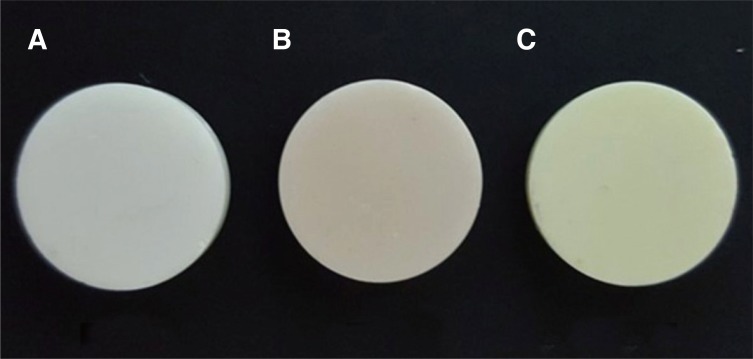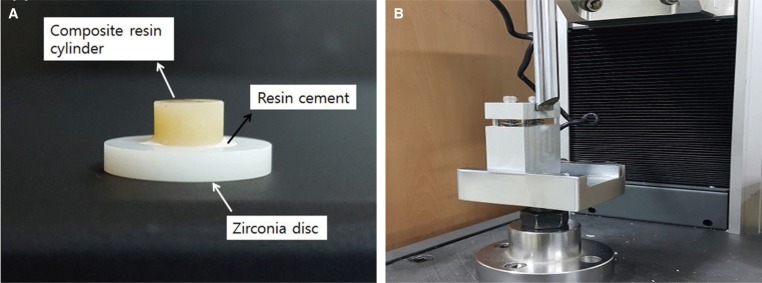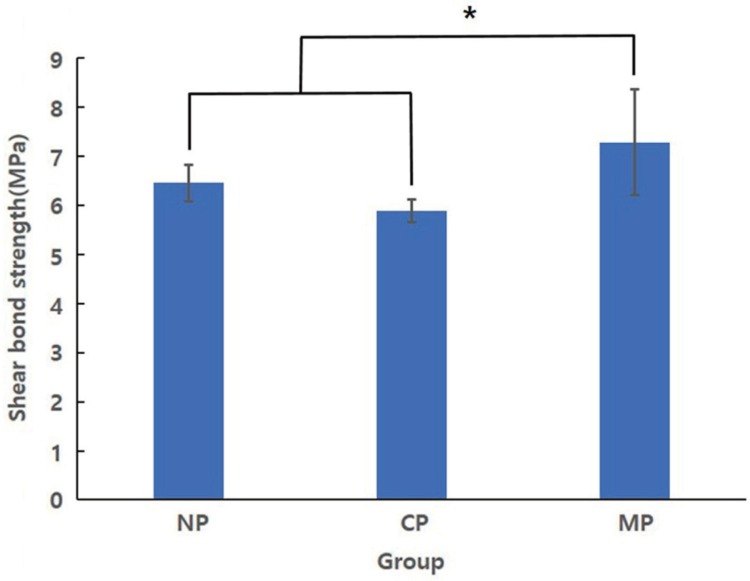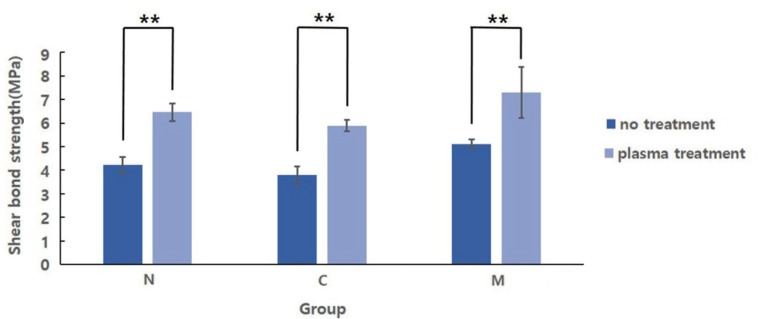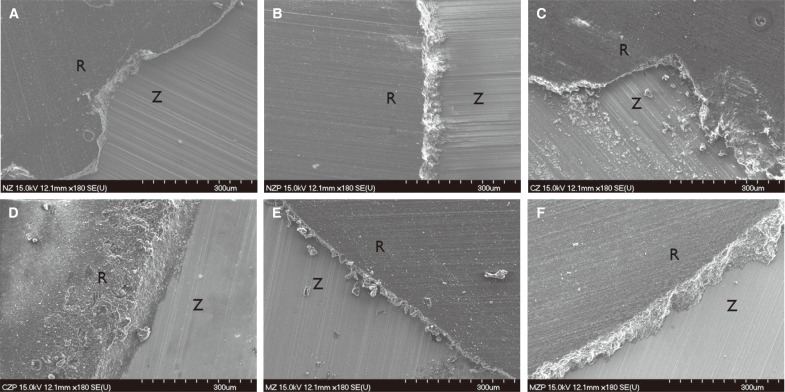J Adv Prosthodont.
2017 Apr;9(2):118-123. 10.4047/jap.2017.9.2.118.
The effect of plasma on shear bond strength between resin cement and colored zirconia
- Affiliations
-
- 1Department of Prosthodontics, School of Dentistry, Chonnam National University, Gwangju, Republic of Korea. mcnihil@jnu.ac.kr
- KMID: 2376299
- DOI: http://doi.org/10.4047/jap.2017.9.2.118
Abstract
- PURPOSE
To investigate the effect of non-thermal atmospheric pressure plasma (NTAPP) treatment on shear bond strength (SBS) between resin cement and colored zirconia made with metal chlorides.
MATERIALS AND METHODS
60 zirconia specimens were divided into 3 groups using coloring liquid. Each group was divided again into 2 sub-groups using plasma treatment; the experimental group was treated with plasma, and the control group was untreated. The sub-groups were: N (non-colored), C (0.1 wt% aqueous chromium chloride solution), M (0.1 wt% aqueous molybdenum chloride solution), NP (non-colored with plasma), CP (0.1 wt% aqueous chromium chloride solution with plasma), and MP (0.1 wt% aqueous molybdenum chloride solution with plasma). Composite resin cylinders were bonded to zirconia specimens with MDP-based resin cement, and SBS was measured using a universal testing machine. All data was analyzed statistically using a 2-way ANOVA test and a Tukey test.
RESULTS
SBS significantly increased when specimens were treated with NTAPP regardless of coloring (P<.001). Colored zirconia containing molybdenum showed the highest value of SBS, regardless of NTAPP. The molybdenum group showed the highest SBS, whereas the chromium group showed the lowest.
CONCLUSION
NTAPP may increase the SBS of colored zirconia and resin cement. The NTAPP effect on SBS is not influenced by the presence of zirconia coloring.
Keyword
MeSH Terms
Figure
Cited by 1 articles
-
Influence of nonthermal argon plasma on the shear bond strength between zirconia and different adhesives and luting composites after artificial aging
Philipp-Cornelius Pott, Timo-Sebastian Syväri, Meike Stiesch, Michael Eisenburger
J Adv Prosthodont. 2018;10(4):308-314. doi: 10.4047/jap.2018.10.4.308.
Reference
-
1. Preis V, Behr M, Kolbeck C, Hahnel S, Handel G, Rosentritt M. Wear performance of substructure ceramics and veneering porcelains. Dent Mater. 2011; 27:796–804. PMID: 21524788.
Article2. Aboushelib MN, de Jager N, Kleverlaan CJ, Feilzer AJ. Microtensile bond strength of different components of core veneered all-ceramic restorations. Dent Mater. 2005; 21:984–991. PMID: 16085302.
Article3. Heffernan MJ, Aquilino SA, Diaz-Arnold AM, Haselton DR, Stanford CM, Vargas MA. Relative translucency of six all-ceramic systems. Part II: core and veneer materials. J Prosthet Dent. 2002; 88:10–15. PMID: 12239473.
Article4. Yuan JC, Brewer JD, Monaco EA Jr, Davis EL. Defining a natural tooth color space based on a 3-dimensional shade system. J Prosthet Dent. 2007; 98:110–119. PMID: 17692592.
Article5. Oh GJ, Lee KM, Lee DJ, Lim HP, Yun KD, Ban JS, Lee KK, Fisher JG, Park SW. Effect of metal chloride solutions on coloration and biaxial flexural strength of yttria-stabilized zirconia. Met Mater Int. 2012; 18:805–812.
Article6. Kim GH, Park SW, Lee K, Oh GJ, Lim HP. Shear bond strength between resin cement and colored zirconia made with metal chlorides. J Prosthet Dent. 2015; 113:603–608. PMID: 25819355.
Article7. Behr M, Proff P, Kolbeck C, Langrieger S, Kunze J, Handel G, Rosentritt M. The bond strength of the resin-to-zirconia interface using different bonding concepts. J Mech Behav Biomed Mater. 2011; 4:2–8. PMID: 21094475.
Article8. Chang JC, Powers JM, Hart D. Bond strength of composite to alloy treated with bonding systems. J Prosthodont. 1993; 2:110–114. PMID: 8242163.
Article9. Blatz MB, Sadan A, Martin J, Lang B. In vitro evaluation of shear bond strengths of resin to densely-sintered high-purity zirconium-oxide ceramic after long-term storage and thermal cycling. J Prosthet Dent. 2004; 91:356–362. PMID: 15116037.
Article10. Phark JH, Duarte S Jr, Blatz M, Sadan A. An in vitro evaluation of the long-term resin bond to a new densely sintered high-purity zirconium-oxide ceramic surface. J Prosthet Dent. 2009; 101:29–38. PMID: 19105989.
Article11. von Woedtke T, Metelmann HR, Weltmann KD. Clinical plasma medicine: state and perspectives of in vivo application of cold atmospheric plasma. Contributions Plasma Phys. 2014; 54:104–117.12. Derand T, Molin M, Kvam K. Bond strength of composite luting cement to zirconia ceramic surfaces. Dent Mater. 2005; 21:1158–1162. PMID: 16005508.
Article13. Canullo L, Micarelli C, Bettazzoni L, Koçi B, Baldissara P. Zirconia-composite bonding after plasma of argon treatment. Int J Prosthodont. 2014; 27:267–269. PMID: 24905269.
Article14. Shim JW, Lee K, Jeong MJ, Jung SC, Kim BH. Hyaluronic acid immobilization on the poly-allylamine coated nano-network TiO2 surface. J Nanosci Nanotechnol. 2011; 11:7343–7346. PMID: 22103192.
Article15. Rammelt S, Illert T, Bierbaum S, Scharnweber D, Zwipp H, Schneiders W. Coating of titanium implants with collagen, RGD peptide and chondroitin sulfate. Biomaterials. 2006; 27:5561–5571. PMID: 16879866.
Article16. Cales B. Colored zirconia ceramics for dental applications. Bioceram. 1998; 11:591–594.17. Shah K, Holloway JA, Denry IL. Effect of coloring with various metal oxides on the microstructure, color, and flexural strength of 3Y-TZP. J Biomed Mater Res B Appl Biomater. 2008; 87:329–337. PMID: 18433010.
Article18. Ueno T, Kumagai T, Hirota K, Saitoh Y, Kojima I. The characteristic of metal adhesion primer GC Metal Primer II. J Dent Res. 1997; 76:312.19. Beuer F, Erdelt K, Schweiger J, Eichberger M. Flexural strength of coloured and aged zirconia. J Dent Res. 2004; 83:942–954.20. Bartolomé JF, Díaz M, Moya JS. Influence of the metal particle size on the crack growth resistance in mullite-molybdenum composites. J Am Ceram Soc. 2002; 85:2778–2784.
Article21. Sbaizero O, Roitti S, Pezzotti G. R-curve behavior of alumina toughened with molybdenum and zirconia particles. Mat Sci Eng A. 2003; 359:297–302.
Article22. Khan AA, Labbe JC. Aluminium nitride–molybdenum ceramic matrix composites: influence of molybdenum concentration on the mechanical properties. J Mater Sci. 1997; 32:3829–3833.23. Ozcan M, Vallittu PK. Effect of surface conditioning methods on the bond strength of luting cement to ceramics. Dent Mater. 2003; 19:725–731. PMID: 14511730.24. Kern M, Wegner SM. Bonding to zirconia ceramic: adhesion methods and their durability. Dent Mater. 1998; 14:64–71. PMID: 9972153.
Article25. Wegner SM, Gerdes W, Kern M. Effect of different artificial aging conditions on ceramic-composite bond strength. Int J Prosthodont. 2002; 15:267–272. PMID: 12066490.26. Lüthy H, Loeffel O, Hammerle CH. Effect of thermocycling on bond strength of luting cements to zirconia ceramic. Dent Mater. 2006; 22:195–200. PMID: 16143382.27. Silva NR, Coelho PG, Valverde GB, Becker K, Ihrke R, Quade A, Thompson VP. Surface characterization of Ti and Y-TZP following non-thermal plasma exposure. J Biomed Mater Res B Appl Biomater. 2011; 99:199–206. PMID: 21714084.
Article28. Kim JH, Lee MA, Han GJ, Cho BH. Plasma in dentistry: a review of basic concepts and applications in dentistry. Acta Odontol Scand. 2014; 72:1–12. PMID: 24354926.
Article29. Zhang W, Chu PK, Ji J, Zhang Y, Liu X, Fu RK, Ha PC, Yan Q. Plasma surface modification of poly vinyl chloride for improvement of antibacterial properties. Biomaterials. 2006; 27:44–51. PMID: 16005957.
Article30. Yavirach P, Chaijareenont P, Boonyawan D, Pattamapun K, Tunma S, Takahashi H, Arksornnukit M. Effects of plasma treatment on the shear bond strength between fiber-reinforced composite posts and resin composite for core buildup. Dent Mater J. 2009; 28:686–692. PMID: 20019419.
Article31. Yoshida K, Tsuo Y, Atsuta M. Bonding of dual-cured resin cement to zirconia ceramic using phosphate acid ester monomer and zirconate coupler. J Biomed Mater Res B Appl Biomater. 2006; 77:28–33. PMID: 16193486.
Article
- Full Text Links
- Actions
-
Cited
- CITED
-
- Close
- Share
- Similar articles
-
- Effect of various surface treatment methods of highly translucent zirconia on the shear bond strength with resin cement
- Evaluation of shear bond strengths of gingiva-colored composite resin to porcelain, metal and zirconia substrates
- Influence of sandblasting and primer on shear bond strength of resin cement to zirconia
- Shear Bonding Strength of Three Cements Luted on Pediatric Zirconia Crowns and Dentin of Primary Teeth
- The effect of surface treatment conditioning on shear bond strength between zirconia and dental resin cements

